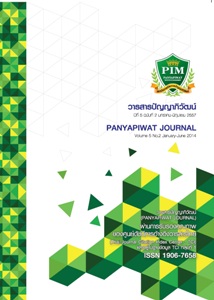USING COMPUTER-MEDIATED COMMUNICATION CHAT TO PROMOTE EFL STUDENTS’ LANGUAGE COMMUNICATION AT BANGKOK UNIVERSITY
Main Article Content
บทคัดย่อ
Abstract
The purpose of the study was to examine the synchronous (together at the same time) discussion chat supported by a network system known as Computer-Mediated Communication (CMC). Twenty-eight students who were studying English as a foreign language at Bangkok University read an article and discussed assigned questions through a software system called “Webex Meetings. Their chat transcripts were examined by means of content analysis. Unique characteristics of language and interaction in discussion chat were found to be similar to those in face-to-face communication. The questionnaire results revealed students’ positive perceptions about this mode of communication.
บทคัดย่อ
งานวิจัยนี้มีวัตถุประสงค์เพื่อศึกษาการพูดคุยเชิงอภิปรายแบบออนไลน์พร้อมกันผ่านเครือข่ายการสื่อสารผ่านคอมพิวเตอร์ กลุ่มตัวอย่างคือนักศึกษามหาวิทยาลัยกรุงเทพ จำนวน 28 คน ที่เรียนภาษาอังกฤษเป็นภาษาต่างประเทศอ่านบทความภาษาอังกฤษและพูดคุยเชิงอภิปรายแบบออนไลน์ด้วยโปรแกรมคอมพิวเตอร์ Webex Meetings นำข้อความการพูดคุยเชิงอภิปรายแบบออนไลน์มาวิเคราะห์เชิงเนื้อหา พบว่ามีรูปแบบการใช้ภาษาเฉพาะตัวและมีปฏิสัมพันธ์กันคล้ายกับการสื่อสารแบบตัวต่อตัว ผลการวิเคราะห์แบบสอบถามแสดงให้เห็นทัศนะเชิงบวกของกลุ่มตัวอย่างต่อการสื่อสารในรูปแบบออนไลน์
Article Details
“ข้าพเจ้าและผู้เขียนร่วม (ถ้ามี) ขอรับรองว่า บทความที่เสนอมานี้ยังไม่เคยได้รับการตีพิมพ์และไม่ได้อยู่ระหว่างกระบวนการพิจารณาลงตีพิมพ์ในวารสารหรือแหล่งเผยแพร่อื่นใด ข้าพเจ้าและผู้เขียนร่วมยอมรับหลักเกณฑ์การพิจารณาต้นฉบับ ทั้งยินยอมให้กองบรรณาธิการมีสิทธิ์พิจารณาและตรวจแก้ต้นฉบับได้ตามที่เห็นสมควร พร้อมนี้ขอมอบลิขสิทธิ์บทความที่ได้รับการตีพิมพ์ให้แก่สถาบันการจัดการปัญญาภิวัฒน์หากมีการฟ้องร้องเรื่องการละเมิดลิขสิทธิ์เกี่ยวกับภาพ กราฟ ข้อความส่วนใดส่วนหนึ่งและ/หรือข้อคิดเห็นที่ปรากฏในบทความข้าพเจ้าและผู้เขียนร่วมยินยอมรับผิดชอบแต่เพียงฝ่ายเดียว”
References
Cvjetkovic, S. (2010). Computer-Mediated Communication: A Study of Language Variation on Internet Chat . Retrieved June 13, 2013, from https://gupea.ub.gu.se/bitstream/2077/22616/1/gupea 2077 22616 1.pdf
Chat. (2013). In Dictionary.com. Retrieved January 3, 2013, from http://dictionary.reference.com/browse/chat
Ellis, R. & Barkhuizen, G. (2005). Analysing Learner Language. China: Oxford University Press.
Freiermuth, M. (2002). Internet Chat: Collaborating and Learning via E-Conversations. TESOL Journal,11(3), 36-40.
Herring, S. (2001). Computer-Mediated Discourse. In D. Schiffrin, D. Tannen, & H.E. Hamilton (Eds.),The Handbook of Discourse Analysis. Massachusetts: Blackwell Publishers Ltd.
Ingram, A. & Hathorn, L. (2004). Methods for Analyzing Collaboration in Online Communications. In T. Roberts (Ed.), Online Collaborative Learning: Theory and Practice (pp. 215-241).Singapore: Information Science Publishing.
Kung, S. (2004). Synchronous electronic discussions in an EFL reading class. ELT Journal, 58(2),164-173. Retrieved November 12, 2012, from http://203.72.145.166/ELT/files/58-2-7.pdf
Lee, L. (2002). Synchronous online exchanges: a study of modification devices on non-native discourse. System, 30, 275-288.
Mollering, M. & Ritter, M. (2008). CMC and Intercultural Learning. In F. Zhang & B. Barber (Eds.), Computer-Enhanced Language Acquisition and Learning. New York: Information Science Reference.
Murray, D. (2000). Protean Communication: The Language of Computer-Mediated Communication. TESOL Quarterly, 34(3), 397-421.
Naidu, 5 & Javela, S. (2006). Analyzing CMC content for what? Computers & Education, 46, 96-103. Retrieved November 10, 2012, from http://moodle.fct.unl.pt/pluginfile.php/54370/mod_page/content/1/gerais/sdarticle. pdf
Salaberry, M.R. (2000). L2 Morphosyntactic Development in Text-Based Computer-Mediated Communication. Computer Assisted Language Learning, 13(1), 5-27. Retrieved October 25,2012, from https://webspace.utexas.edu/mrs2429/www/Salaberry2000CALL.pdf
Sotillo, S. (2000). Discourse functions and syntactic complexity in synchronous and asynchronous communication. Language Learning & Technology, 4(1), 82-119.
Strauss, A., & Corbin, J. (1990). Basics of qualitative research: Grounded theory procedures and techniques. Newbury Park, CA: Sage Publications, Inc.
Treleaven, L. (2004). A New Taxonomy for Evaluation Studies of Online Collaborative Learning. In T. Roberts (Ed.), Online Collaborative Learning: Theory and Practice. Singapore: Information Science Publishing.
Wagner, J. (1996). Foreign Language Acquisition through Interaction-A Critical Review of Research on Conversational Adjustments. Journal of Pragmatics, 26, 215-235. Retrieved September
, 2012, from http://www.sciencedirect.com/science/article/pii/0378216696000136
Weigle. S. (2002). Assessing Writing. UK: Cambridge University Press.
Werry, C. (1996). Linguistic and Interactional Features of Internet Relay Chat. Philadelphia : John Benjamins Publishing Company.
Herring, C. (2001), Computer-Mediated Communication. Philadelphia: John Benjamins Publishing Company.

